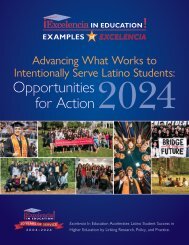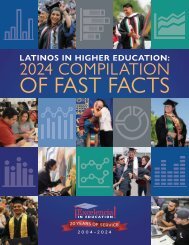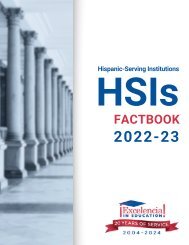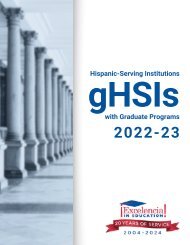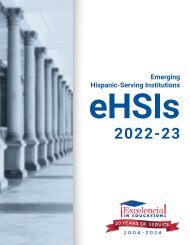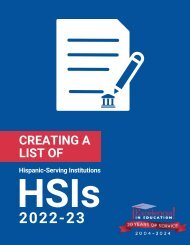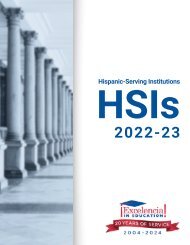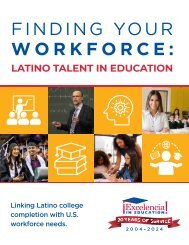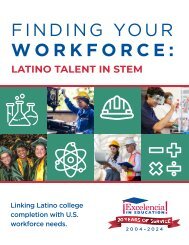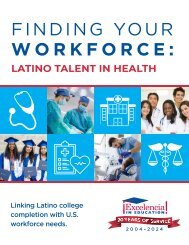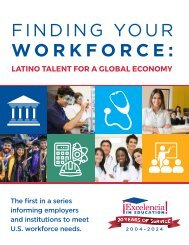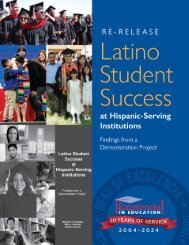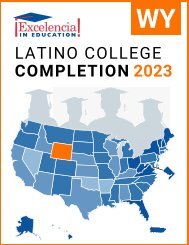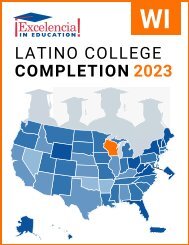Latino College Completion 2023: South Dakota
You also want an ePaper? Increase the reach of your titles
YUMPU automatically turns print PDFs into web optimized ePapers that Google loves.
SD
LATINO COLLEGE COMPLETION:<br />
SOUTH DAKOTA – <strong>2023</strong><br />
For the U.S. to regain the top ranking in the world for college degree<br />
attainment, <strong>Latino</strong>s will need to earn 6.2 million degrees by 2030. 1<br />
FAST FACTS<br />
STATE RANKING:<br />
<strong>South</strong> <strong>Dakota</strong> had the 46th largest<br />
<strong>Latino</strong> population in the U.S.<br />
K-12 POPULATION:<br />
In <strong>South</strong> <strong>Dakota</strong>, 7% of the K-12<br />
population was <strong>Latino</strong>. 2<br />
POPULATION:<br />
In <strong>South</strong> <strong>Dakota</strong>, 4% of the<br />
population was <strong>Latino</strong>. 2<br />
MEDIAN AGE:<br />
The median age<br />
of Hispanics in<br />
<strong>South</strong> <strong>Dakota</strong> was<br />
22, compared<br />
to 41 for White<br />
non-Hispanics. 2<br />
22<br />
Hispanics<br />
41<br />
White<br />
non-Hispanics<br />
ENROLLMENT:<br />
In <strong>South</strong> <strong>Dakota</strong>, 15% of<br />
Hispanics (ages 18 to 34) were<br />
enrolled in higher education, compared<br />
to 21% of White non-Hispanics. 2<br />
DEGREE ATTAINMENT:<br />
In <strong>South</strong> <strong>Dakota</strong>, 29% of Hispanic<br />
adults (25 and older) had earned an<br />
associate degree or higher, compared to<br />
46% of White non-Hispanic adults. 2<br />
Hispanic Adults = 2.9 of 10<br />
To reach the degree attainment goal by 2030, the U.S. can: close<br />
the degree completion gap by accelerating <strong>Latino</strong> completion while<br />
increasing for all students and scale up programs and initiatives that<br />
work for <strong>Latino</strong>, and all, students. The following demographics,<br />
institutional data, and practices inform <strong>Latino</strong> degree attainment.<br />
ENROLLING: Top 5 Institutions (Hispanic Undergraduates) in <strong>South</strong> <strong>Dakota</strong>, 2021-22<br />
Institution<br />
Sector<br />
Grand Hispanic %<br />
Total Total Hispanic<br />
1 University of <strong>South</strong> <strong>Dakota</strong> Public, 4-year 5,328 240 5%<br />
2 <strong>South</strong> <strong>Dakota</strong> State University Public, 4-year 8,651 221 3%<br />
Private forprofit,<br />
4-year<br />
3 National American University-Rapid City<br />
937 124 13%<br />
<strong>South</strong> <strong>Dakota</strong> School of Mines and<br />
4 Technology<br />
Public, 4-year 1,976 106 5%<br />
5 <strong>Dakota</strong> State University Public, 4-year 1,910 94 5%<br />
ASSOCIATE DEGREES: Top 5 Institutions Awarding to Hispanics in <strong>South</strong> <strong>Dakota</strong>, 2020-21<br />
Institution<br />
Sector<br />
Grand<br />
Total<br />
NOTE: We use the terms <strong>Latino</strong> and Hispanic interchangeably in this factsheet.<br />
Hispanic<br />
Total<br />
Source: Excelencia in Education analysis using U.S. Department of Education, National Center for<br />
Education Statistics (NCES), Integrated Postsecondary Education Data System (IPEDS), 2021 Fall<br />
Enrollment, Graduation Rates Survey and Institutional Characteristics Survey.<br />
%<br />
Hispanic<br />
Private forprofit,<br />
4-year<br />
1 National American University-Rapid City<br />
106 13 12%<br />
2 <strong>South</strong>east Technical <strong>College</strong> Public, 2-year 619 13 2%<br />
3 Mitchell Technical <strong>College</strong> Public, 2-year 321 11 3%<br />
4 Western <strong>Dakota</strong> Technical <strong>College</strong> Public, 2-year 226 10 4%<br />
5 Lake Area Technical <strong>College</strong> Public, 2-year 571 8 1%<br />
BACHELOR DEGREES: Top 5 Institutions Awarding to Hispanics in <strong>South</strong> <strong>Dakota</strong>, 2020-21<br />
Institution<br />
Sector<br />
Grand Hispanic %<br />
Total Total Hispanic<br />
1 University of <strong>South</strong> <strong>Dakota</strong> Public, 4-year 1,230 37 3%<br />
2 <strong>South</strong> <strong>Dakota</strong> State University Public, 4-year 1,850 37 2%<br />
Private forprofit,<br />
4-year<br />
3 National American University-Rapid City<br />
244 28 11%<br />
4 Black Hills State University Public, 4-year 423 25 6%<br />
<strong>South</strong> <strong>Dakota</strong> School of Mines and<br />
5 Technology<br />
Public, 4-year 352 16 5%<br />
White Adults = 4.6 of 10<br />
1 Projections to 2030: Excelencia in Education. (2020). Ensuring America’s Future: Benchmarking <strong>Latino</strong><br />
<strong>College</strong> <strong>Completion</strong> to 2030. Excelencia in Education. Washington, D.C.<br />
2 U.S. Census Bureau, 2021 American Community Survey 1-Year Estimates
<strong>South</strong> <strong>Dakota</strong> Gap in Degree <strong>Completion</strong><br />
Closing the degree completion gap can be tracked<br />
by the 4 measures shown below. Alone, none<br />
of these measures capture the entire “story” of<br />
degree completion. However, in combination,<br />
they provide a useful picture of the gap in degree<br />
attainment between Hispanic and White non-<br />
Hispanic cohorts in a single year.<br />
Graduation Rate — Total percentage of students<br />
who graduated within 150% of normal time for<br />
first-time, full-time freshmen. This incorporates<br />
students that graduated in 3 years at two-year<br />
institutions, or in 6 years at four-year institutions.<br />
Transferred to Another Institution —<br />
Percentage of students that transferred to another<br />
institution and did not complete a degree.<br />
Still Enrolled — Percentage of students that are<br />
still enrolled at the point of 150% normal time to<br />
completion.<br />
No Longer Enrolled — Percentage of students<br />
that are no longer enrolled at the point of 150%<br />
normal time to completion.<br />
At two-year institutions, Hispanics’<br />
graduation rate was 20%-points<br />
lower than that of their White non-<br />
Hispanic peers in <strong>South</strong> <strong>Dakota</strong>.<br />
TWO-YEAR INSTITUTIONS<br />
1%<br />
24%<br />
5%<br />
69%<br />
WHITE<br />
-20%<br />
DEGREE OUTCOMES<br />
At four-year institutions, Hispanics’<br />
graduation rate was 20%-points<br />
lower than that of their White<br />
non-Hispanic peers in <strong>South</strong><br />
<strong>Dakota</strong>.<br />
FOUR-YEAR INSTITUTIONS<br />
31%<br />
43%<br />
■ No Longer Enrolled<br />
2%<br />
■ Still Enrolled<br />
9%<br />
2%<br />
6% 1%<br />
■ Transferred to<br />
Another Institution<br />
-20%<br />
■ Graduation Rate<br />
59%<br />
49%<br />
HISPANIC<br />
*Percentages may not add up to 100% due to rounding.<br />
WHITE<br />
44%<br />
15%<br />
39%<br />
HISPANIC<br />
NOTE: Outcomes shown are for students at two-year institutions who started in Fall 2018, and<br />
for students at four-year institutions who started in Fall 2015.<br />
Source: Excelencia in Education analysis using the U.S. Department of Education, National<br />
Center for Education Statistics (NCES), Integrated Postsecondary Education Data System, 2021<br />
Graduation Rates Survey and the Institutional Characteristics Survey.<br />
Examples of What Works for <strong>Latino</strong> Students<br />
There are institutions showing success in enrolling, retaining, and graduating <strong>Latino</strong> students. The following are examples of<br />
programs across the country with evidence of effectiveness in serving <strong>Latino</strong> students nominated for Examples of Excelencia.<br />
The Compact Scholars Program provides undergraduate students<br />
academic, social support, and the opportunity to cultivate a sense of<br />
identity in connection to their academic work and community. The<br />
program seeks to eliminate the national achievement gap in <strong>Latino</strong><br />
college completion. Established in 2006, Compact Scholars was<br />
designed as the postsecondary component of Compact for Success’<br />
partnership between the Sweetwater Union High School District<br />
(SUHSD) and San Diego State University (SDSU) to promote higher<br />
graduation rates for Sweetwater District students, a majority of<br />
whom are <strong>Latino</strong>. Compact for Success offers undergraduate students<br />
first-year experiences, holistic intrusive academic advising, peer/<br />
faculty mentoring, and experiential learning including study abroad<br />
opportunities, undergraduate research, and service-learning. Program<br />
participants also have the opportunity to apply for scholarships<br />
which can help cover costs of experiential learning activities including<br />
internships, service learning, research and other creative activities.<br />
As of Fall 2019, 318 <strong>Latino</strong> students served had enrolled in college<br />
compared to only 84 students as of Fall 2006. As of 2019, one-year<br />
continuation rates for <strong>Latino</strong> program participants is 86%, compared<br />
to 84% for <strong>Latino</strong>, non-program participants. In 2000, the six-year<br />
graduation rate for SUHSD <strong>Latino</strong> students at SDSU was only 38%. As<br />
of 2019, 69% of <strong>Latino</strong> program participants graduated within 6 years<br />
compared to 65% for <strong>Latino</strong>, non-program participants.<br />
For more information on institutional programs improving <strong>Latino</strong> student success in higher education, access Excelencia in<br />
Education’s Growing What Works database at http://www.edexcelencia.org/growing-what-works<br />
ENSURING AMERICA’S FUTURE BY INCREASING LATINO COLLEGE COMPLETION • WWW.EDEXCELENCIA.ORG




